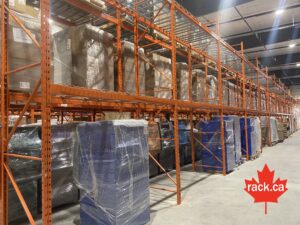A storage system is one of the most important elements in a warehouse, especially when it comes to organizing inventory. There are different types of warehouse storage systems, such as pallet racking, floor stacking, mobile shelving, multi-tier racking, etc. However, this article will be focusing on pallet racking and floor-stacking storage systems.
Every warehouse needs a storage system for efficient and productive warehouse operations. Which is better? Pallet racking or floor stacking? Read on to learn more about the two storage systems.
What Is Pallet Racking? 
Pallet racking is the oldest of the two storage systems. It was first used in the early 1900s. Pallet racking is an industrial storage system that uses vertical frames, horizontal beams, and pallets to store goods in a high-density arrangement. The height, depth, width, and weight capacity of each rack will depend on its design.
Pallet racking is commonly used in warehouses and manufacturing facilities because it allows for efficient use of space. Pallet racking also offers easy access to inventory, allowing for quick retrieval of goods when needed.
What Is Floor Stacking?
Floor stacking became popular in the early 2000s. It is a method of warehousing in which pallets are stacked directly on the floor, in organized rows. Due to the inefficient use of vertical space, a lot of floor space is needed for it.
Floor stacking involves placing items directly onto the floor without any type of shelving or racking system in place. This method can be useful when storing smaller items that don’t require as much organization or space-saving solutions as larger items do with pallet racks. Floor stacking also makes it easier to move around heavy objects.
Difference Between Pallet Racking and Floor Stacking
Take a look at the Differences between the two storage systems examined below.
| Pallet Racking | Floor Stacking | |
| Safety | Reduces clutter and increases floor space, eliminating common warehouse hazards such as tripping and falling, which cause injury. Allows for neat storage of goods and reduces the likelihood of them falling off shelves. Its steel frames are attached to the warehouse floor to improve safety and stability. | Floor stacking can help to reduce the risk of injury from falls or other accidents due to its stable design. Ensures that items are stored safely and securely if done correctly. Make it easier for people to access items, as they don’t have to reach up high or down low, which reduces the risk of injury. |
| Types | There are a few different types of pallet racking, including cantilever racking, mobile racking, push back racking, selective racking, and drive-in racking. | Floor stacking does not require any type of storage equipment. Stocks are placed directly on the floor and stacked to a maximum stable storage height. |
| Storage Density | High density storage | Low density storage |
| Flexibility | Pallet racking is more flexible than floor stacking because it provides greater access to stored goods, allowing for faster retrieval times. | It is also flexible as it does not require additional tools to rearrange or expand inventory. |
| Strength and Durability | Pallet flow racks are strong and durable. They are made from heavy-duty steel, which is resistant to bending or breaking. | Floor stacking is also durable when the items are stacked correctly, that is, with top-heavy items on the bottom of the stack. |
| Capacity | Though, capacity of pallet racking varies depending on load weight and size, a typical pallet rack system can hold up to 10,000 lbs. per bay. | The maximum capacity of floor stacking varies depending on the type and weight of the items and strength of the floor. The maximum allowable load per square foot is between 1,500 and 2,000 lbs. |
| Size | Pallet racks come in different sizes, materials, and loads. The standard size is 48” L x 40” W. It is ideal for storing heavy loads. | Ideal for storing light loads since items are stacked on top of one another. |
| Application | Pallet racks can be used for different types of loads. It is best for perishable items as it mostly uses the FIFO system. | Floor stacking is best for non-perishable items. It typically uses LIFO technique. |
Which One Is Better for Your Business?

Pallet racking is a better option due to its numerous benefits. Floor stacking is not suitable for all warehouses and consumes more space because it cannot hold items as high pallet racks, making it difficult to maximize storage space. In contrast, a pallet racking system has a high storage density.
Floor stacking also increases the risk of employee injury as a result of items falling off because of lack of separation and support by a pallet racking structure. Pallet racking, supports FIFO inventory management, and is also ideal for perishable goods that cannot be stacked on top of one another.
Contact Canadian Rack Technologies Inc. for Pallet Racking
Canadian Rack Technologies Inc. is one of the leading providers of both new and used pallet racking systems in Canada. We provide different types of racking systems, including carton flow racks, push back, drive-in, cantilever pallet racking, mezzanines, double deep pallet racking, very narrow aisle pallet racking (VNA), selective pallet racking, and more. Contact us today to learn more.

